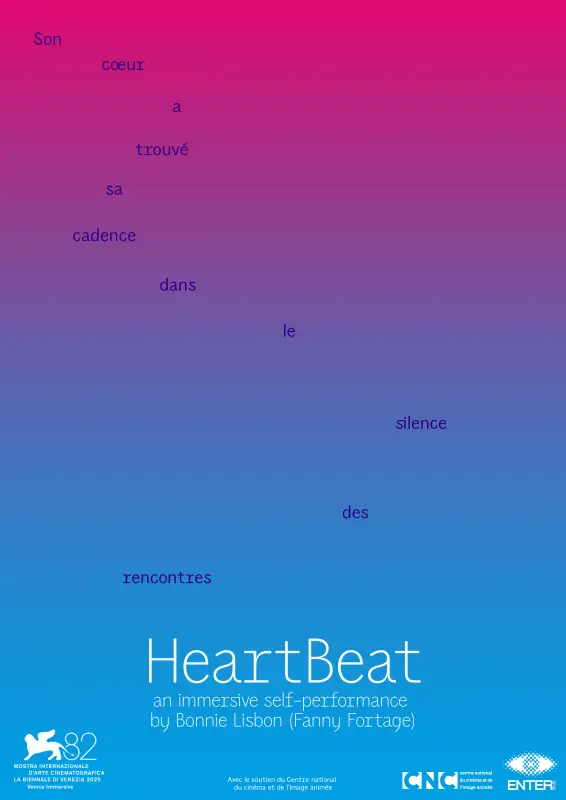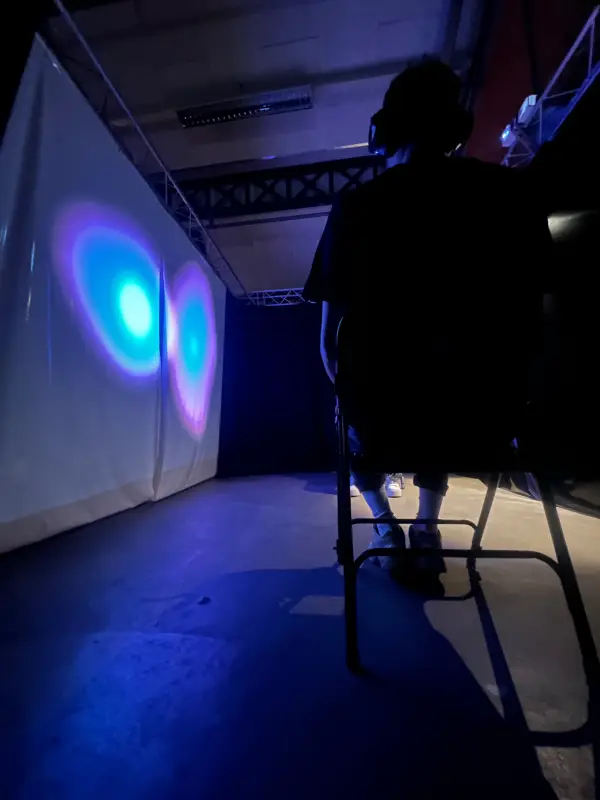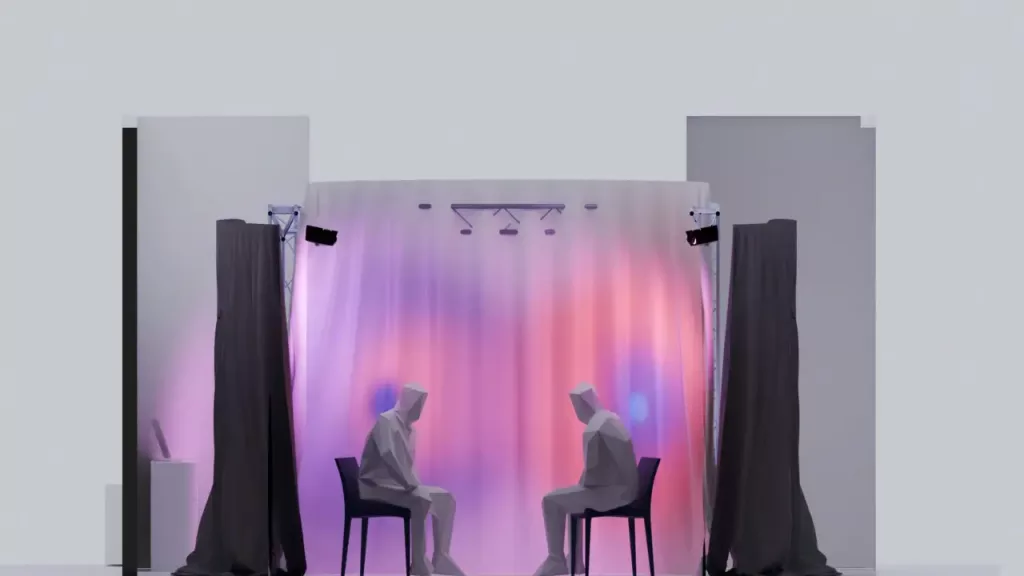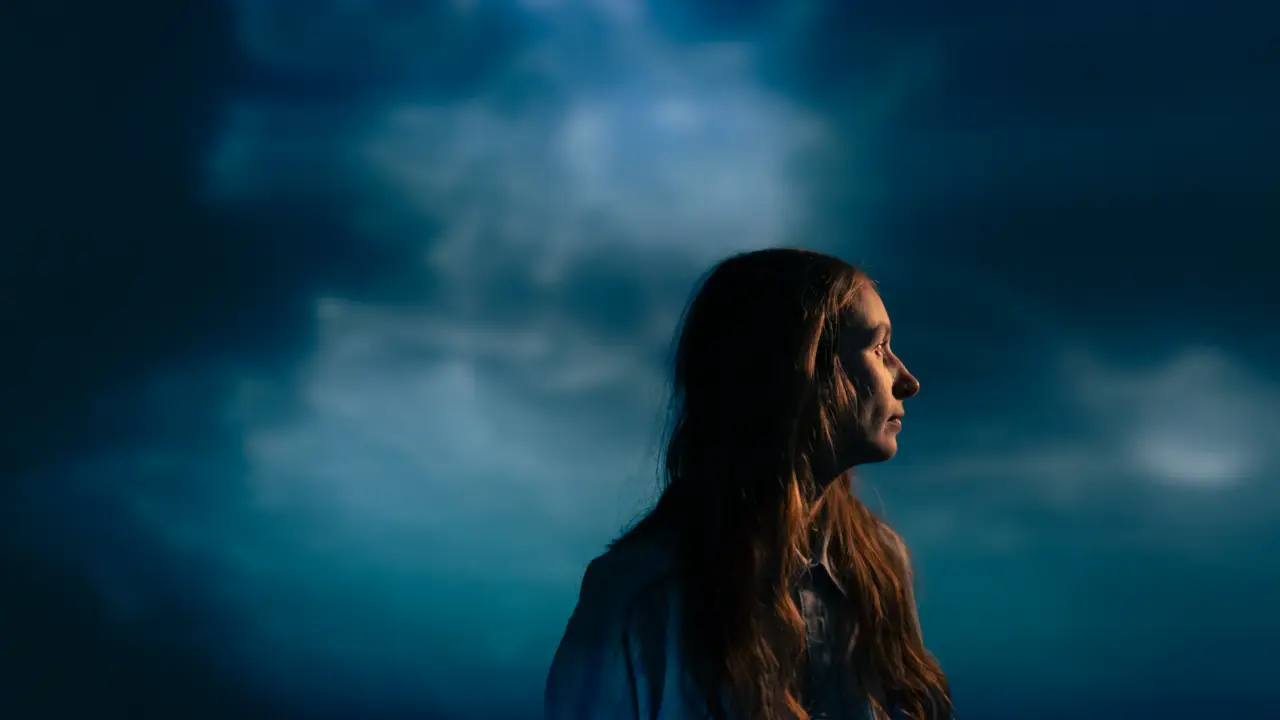At Venice Immersive 2025, Bonnie Lisbon presents the immersive film HEARTBEAT – SON CŒUR A TROUVÉ SA CADENCE DANS LE SILENCE DES RENCONTRES, a 12-minute French work whose minimalist beauty is matched only by the subtlety of its emotions. ENTER.black, a young studio at the crossroads of video and scenography founded by Fanny Fortage (alias Bonnie Lisbon), this first work enters the field of immersive and interactive experiences with the aim of bringing technology out of the screens to make it tangible… and create encounters.
ENTER.black, the first steps: from VJing to discovering teamLab
Bonnie Lisbon (Fanny Fortage) – This is the first time I’ve signed a creation on my own, rather than through the ENTER.black studio, which is nevertheless producing it. I originally come from the world of cinema and audiovisual media. I immersed myself in it from the age of 12, before studying theory at the Sorbonne while preparing for the Louis Lumière school. I was already working for media companies on video content (Konbini, Zadig, etc.), fashion content, music videos, and television shows, and in reality, my freelance work took precedence over continuing my studies after my bachelor’s degree. I mainly worked on large music productions as an assistant director, which brought me into the world of music and, in particular, VJing, which involved working on visual installations for large Parisian tech-savvy collectives. This allowed me to work on the large amount of video content I was filming without ultimately using it. I performed at La Gaîté Lyrique, Le Trabendo, La Boule Noire, Le Nouveau Casino, GLAZART Paris, and other venues.
B. L. – The revelation came during a trip to Japan, where I visited teamLab. I was already doing video projections on people’s faces for art projects. But teamLab manages to make digital art accessible to everyone in a very open way. At the time, this approach was very different from our cultural venues in France and Europe. There, it is both very simple in appearance and very striking. It was from there that I developed the LE METAMORPHEUR project, a facial micro-mapping photo booth, and we founded the ENTER.Black studio. We were quickly incubated at 104Factory (see our article), which helped us a lot to move forward, and we won a PIA grant to develop a program around video correction on faces using augmented reality. We were able to present LE METAMORPHEUR at various events in France and internationally, such as the Taiwan Creative Content Fest (TCCF) organized by TAICCA in Taiwan.
HEARTBEAT – SON CŒUR A TROUVÉ SA CADENCE DANS LE SILENCE DES RENCONTRES, birth of a sensitive project
F. F. – HEARTBEAT was born from a very personal intuition, from listening to my boyfriend’s heartbeat as I lay half asleep. Between dreams and reality, these are moments conducive to the blossoming of ideas, to inspiration… I then thought to myself that it would be fascinating to be able to meet strangers by hearing someone’s heartbeat. Because, ultimately, it’s a sound and a sensation that we experience with our loved ones: a spouse, a baby… But never with a stranger. I started from this observation in the summer of 2024, beginning by asking people around me questions and creating questionnaires about what might interest people in this approach. The concept itself made a big impression, and I started working on it in earnest after being selected for the European Creators Lab (Immersive Residency, Luxembourg, September 2024), where we developed the script and also a first prototype.

F. F. – The development and production of the project involved a great deal of user feedback. We also worked on the narration, which ultimately led to the experience lasting around 12 minutes. We partnered with Irish artist Hugh Farrell (official website), who has created many audio and listening-based works. He helped us preserve the text that leads up to this encounter, which also helps to relax the two people facing each other. They smile at each other, exchange a few words, and then just listen.
F. F. – The idea behind HEARTBEAT is really to create a moment between two complete strangers. It’s not a prerequisite, but the synchronization of heartbeats doesn’t take into account the level of friendship or relationship! So, in reality, it doesn’t matter whether the two spectators know each other or not. We want to avoid the “ah, I’m listening” that two friends would exchange while doing the experiment. The secret to synchronizing is breathing. We are still studying the whys and wherefores, and this has sparked the interest of the UREPSSS research laboratory at the University of Lille, with whom we hope to collaborate. There are still many unknowns on this subject, apprehension during the experiment, and around what can facilitate this form of connection.
F. F. – We also left a book open at the end of the experiment to answer a few questions in pairs. And the surprise was that when two strangers filled it out together after testing HEARTBEAT, there was a form of collaboration, or complicity, in writing joint feedback. It’s an interesting moment.
An aesthetically minimalist design… by intent
F. F. – The scenography came together fairly quickly, through these prototyping residencies. HEARTBEAT is a 3-meter-by-3-meter format, with two seats for the audience and a video projection behind them and on the sides. It is important for us to design a proposal where spectators can look each other in the eye, see each other without going through a digital tool such as a tablet, for example. They can also follow the visual evolution of the experience, their hearts gradually coming closer together (if they are lucky!) on the side of the two participants, which suddenly induces a shared gaze, at the same time, in the same direction in the event of synchronization. And sometimes a little jump of surprise!

F. F. – There were questions about decorating the space where the experience takes place, about a 360-degree project, about the ceiling… But for us, the main thing is the encounter. We didn’t want to fill the entire space, at the risk of losing the audience—or influencing them during their time in the experience. There is a little bit of digital technology, such as connected watches, but otherwise it is very minimal. Even visually, it is minimalist by nature. Our entire proposal is to have as little influence as possible on the audience, even (and especially) when they manage to synchronize. We want to keep the exchange of glances, this form of emotional duel, at the center of everything.
F. F. – My references are Marina Abramović and Christian Boltanski, particularly his Archives du Cœur, which I discovered on the island of Naoshima in Japan. It’s something very pure and very gentle in an art installation. And that’s what I wanted to convey: the performance aspect with genuine sharing. That’s what motivated me during development, but it also brought back memories related to this work: my brother’s coma and listening to his ECG, my first film project at age 12 where I stuck a microphone to listen to my heartbeat… In that sense, HEARTBEAT is filled with capsules of personal memories. And in terms of digital art, I have a real passion for James Turrell with his color schemes and minimalism that play with the viewer, forming environments without ever assaulting the eye.

HEARTBEAT, A world premiere at Venice Immersive 2025
F. F. – We don’t have any plans for this project yet, but we’re already finalizing the presentation for Venice. We’d like to install HEARTBEAT in public spaces, train stations, and on the street if possible. Ideally, we’d like an open space with lots of foot traffic—and for a long period of time. And we hope to have lots of discussions at Venice Immersive about future opportunities!



Leave a Reply
You must be logged in to post a comment.